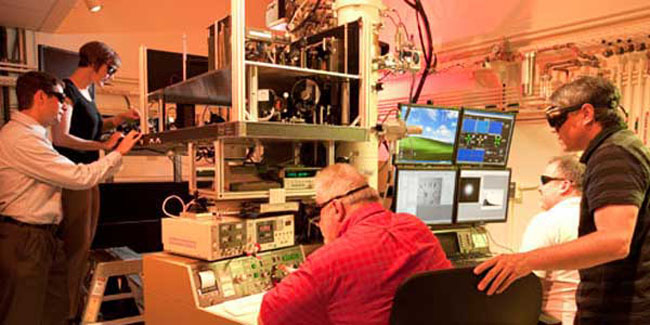Lawrence Livermore scientists, economic development leader garner three awards for technology transfer work
This year's awards will be presented Sept. 6 during the FLC's three-day Far West/Mid-Continent regional meeting at the Hyatt Regency Hotel in San Antonio, Texas.
Started in 1974, the consortium assists the U.S. public and private sectors in utilizing technologies developed by federal government research laboratories.
LLNL shared in awards for the development of a new breast cancer diagnostic system, the commercialization of a transmission electron microscope, and the work of an innovation center that assists small firms in advancing transportation or renewable energy technologies.
Diagnosing breast cancer
A new medical technology, dubbed the "Intelliprobe optical breast cancer diagnostic system," can provide immediate cancer diagnoses and has been developed by scientists from the Russian Federal Nuclear Center, a Livermore-based company, BioTelligent Inc.; and LLNL.
The "Intelliprobe" system may eliminate or substantially reduce the need for biopsies, tissue sample analysis by doctors, and the time for patients to obtain their medical results.
While mammography is one way to detect abnormalities in the human breast, it is not always possible to determine from the imaging results alone whether a growth is benign or cancerous. It is then necessary to obtain a sample or biopsy of the suspect tissue for microscopic examination by a cytologist or pathologist.
Compared with surgical biopsy, the use of the Intelliprobe to perform breast-cancer diagnostic procedures also lowers costs and also reduces pain and scarring.
More importantly, in clinical tests on 165 volunteer patients in Russia, the system provided immediate diagnoses at accuracy levels that rival surgical biopsies and other conventional procedures in detecting cancerous cells. The system was tested in Nizhny Novgorod Regional Oncology Center.
During the procedure, the probe collects data from a microscopic volume of tissue without removing the tissue. As the needle tip moves through the tissue, light scattering and absorption spectra data are being continuously collected. In this system optical scattering spectra are generated continuously as far as the needle-like probe containing one emitting and several collecting optical fibers penetrate through the tissues moving to the suspicious area. That allows analyzing not only the state of the local site, but also the structure of tissues along the needle trace.
Three LLNL employees -- Alexander Rubenchik, a physicist; Paris Althouse, the program manager; and Annemarie Meike, a business development executive - worked on the Intelliprobe project. One of the Lab's two partners, the Russian Federal Nuclear Center, is located in Sarov (formerly called Arzamas-16), about 230 miles east of Moscow.
The project was managed by the U.S. Department of Energy/NNSA's Global Initiatives for Proliferation Prevention (GIPP) program. The goal of NNSA's GIPP program is to team former weapons scientists, technicians and engineers with the U.S. national laboratories and U.S. industry to work together on high technology commercial research and development projects.
Seeing what was previously unseen
An instrument -- called the dynamic transmission electron microscope, or DTEM - that has been developed by LLNL scientists provides never-before-seen details of material processes in 15-nanosecond (billionth of a second) single-shot exposures.
This breakthrough allows material samples to be viewed under extreme conditions to see what happens at the micro- and nano-structural level when materials are subjected to extreme temperatures, high pressures and reactive chemicals.
The DTEM technology, which has been licensed to a Belmont, Calif.-based company, Integrated Dynamic Electron Solutions (IDES), won an FLC award as an example of an "outstanding commercialization success."
After working with LLNL scientists to develop a prototype machine, the firm sold and installed a DTEM at Ecole Polytechnique Federale de Lausanne in Switzerland last year and is now developing concepts for new instruments based on other LLNL technologies.
The continued partnership between LLNL and IDES has resulted in work being conducted under a cooperative research and development agreement. In addition, the firm recently received Small Business Innovation Research funding from the National Institutes of Health to develop other parts of the DTEM technology.
In developing the DTEM, LLNL solved the problem of integrating pulsed lasers into a transmission electron microscope and, through the use of a weak lens coupling system, operating the machine with one million times the electron beam current it was originally designed to use.
While the transmission electron microscope technology had existed for several decades, it was impractical and largely unknown. With the LLNL upgrades and technology transfer, the DTEM has been transformed from a laboratory curiosity into commercial product.
DTEM has garnered a number of industry honors, including the R&D 100, Nano50 and Microscopy Today Innovation awards and is regarded as a technology on the frontier of in situ electron microscopy.
LLNL condensed matter physicists Thomas LaGrange and Bryan Reed have led the DTEM development efforts. Ida Shum, a business development executive in the Lab's Industrial Partnerships Office, has overseen the commercialization work.
Lending a hand to small businesses
Another FLC award, for an outstanding partnership, was garnered by i-GATE (the Innovation for Green Advanced Transportation Excellence), a regional public-private partnership designed to support small businesses and bolster green transportation and clean-energy efforts.
The award recipients include Buck Koonce, LLNL's director of economic development; Bruce Balfour, of Sandia National Laboratories; Rob White, the city of Livermore economic development director; and Louis Stewart, of the California Governor's Office of Business and Economic Development.
i-GATE creates a link between national laboratories and entrepreneurs, industry, innovation network, venture capital and universities to accelerate the commercialization of innovative energy technologies.
After its first year of operation, the i-GATE incubator has assisted in the creation of 62 direct and 118 indirect jobs. Clients range from fuel cell and battery companies to ultra-light commuter rail and solid-state energy harvesters.
Sandia initiated the i-GATE proposal as the lead laboratory with the city of Livermore as administrator. The initial center grew to 26 partners, including 10 cities, county and state government, federal agencies, universities, industry and venture capital in the San Francisco East Bay region. There are now more than 40 i-GATE partners.







